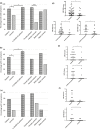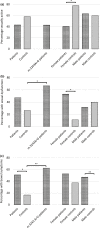Urogenital symptoms in mitochondrial disease: overlooked and undertreated
- PMID: 30884027
- PMCID: PMC6767393
- DOI: 10.1111/ene.13952
Urogenital symptoms in mitochondrial disease: overlooked and undertreated
Abstract
Background and purpose: Bowel symptoms are well documented in mitochondrial disease. However, data concerning other pelvic organs is limited. A large case-control study has therefore been undertaken to determine the presence of lower urinary tract symptoms (LUTS) and sexual dysfunction in adults with genetically confirmed mitochondrial disease.
Methods: Adults with genetically confirmed mitochondrial disease and control subjects were recruited from a specialist mitochondrial clinic. The presence and severity of LUTS and their impact on quality of life, in addition to sexual dysfunction and bowel symptoms, were captured using four validated questionnaires. Subgroup analysis was undertaken in patients harbouring the m.3243A>G MT-TL1 mitochondrial DNA mutation. A subset of patients underwent urodynamic studies to further characterize their LUTS.
Results: Data from 58 patients and 19 controls (gender and age matched) were collected. Adults with mitochondrial disease had significantly more overactive bladder (81.5% vs. 56.3%, P = 0.039) and low stream (34.5% vs. 5.3%, P = 0.013) urinary symptoms than controls. Urodynamic studies in 10 patients confirmed that bladder storage symptoms predominate. Despite high rates of LUTS, none of the patient group was receiving treatment. Female patients and those harbouring the m.3243A>G MT-TL1 mutation experienced significantly more sexual dysfunction than controls (53.1% vs. 11.1%, P = 0.026, and 66.7% vs. 26.3%, P = 0.011, respectively).
Conclusions: Lower urinary tract symptoms are common but undertreated in adult mitochondrial disease, and female patients and those harbouring the m.3243A>G MT-TL1 mutation experience sexual dysfunction. Given their impact on quality of life, screening for and treating LUTS and sexual dysfunction in adults with mitochondrial disease are strongly recommended.
Keywords: bladder symptoms; bowel symptoms; lower gastrointestinal tract symptoms; lower urinary tract symptoms; mitochondrial disease; sexual dysfunction; urogenital symptoms.
© 2019 The Authors. European Journal of Neurology published by John Wiley & Sons Ltd on behalf of European Academy of Neurology.
Conflict of interest statement
Tomoyuki Uchiyama: International Continence Society/Pfizer International Fellowship 2017. All the other authors declare no financial or other conflicts of interest.
Figures


Similar articles
-
Lower urinary tract dysfunction in adult patients with mitochondrial disease.Neurourol Urodyn. 2020 Nov;39(8):2253-2263. doi: 10.1002/nau.24479. Epub 2020 Sep 24. Neurourol Urodyn. 2020. PMID: 32969525
-
A population-based survey of lower urinary tract symptoms (LUTS) and symptom-specific bother: results from the Brazilian LUTS epidemiology study (BLUES).World J Urol. 2013 Dec;31(6):1451-8. doi: 10.1007/s00345-013-1057-8. Epub 2013 Mar 21. World J Urol. 2013. PMID: 23515960
-
Challenges to Longitudinal Characterization of Lower Urinary Tract Dysfunction in Multiple Sclerosis.Mult Scler Relat Disord. 2022 Jun;62:103793. doi: 10.1016/j.msard.2022.103793. Epub 2022 Apr 11. Mult Scler Relat Disord. 2022. PMID: 35461057
-
Assessment and management of male lower urinary tract symptoms (LUTS).Int J Surg. 2016 Jan;25:164-71. doi: 10.1016/j.ijsu.2015.11.043. Epub 2015 Nov 30. Int J Surg. 2016. PMID: 26654899 Review.
-
Lower urinary tract symptoms, nocturia and overactive bladder in patients with depression and anxiety.Psychiatr Pol. 2016;50(2):417-30. doi: 10.12740/PP/OnlineFirst/59162. Psychiatr Pol. 2016. PMID: 27288685 Review. English, Polish.
Cited by
-
Lower urinary tract and bowel dysfunction in spinocerebellar ataxias.Ann Clin Transl Neurol. 2021 Feb;8(2):321-331. doi: 10.1002/acn3.51266. Epub 2020 Dec 18. Ann Clin Transl Neurol. 2021. PMID: 33338328 Free PMC article.
-
Overactive bladder symptoms profile and related factors among women during the perinatal period: a latent profile analysis.BMC Pregnancy Childbirth. 2025 Aug 14;25(1):850. doi: 10.1186/s12884-025-07996-0. BMC Pregnancy Childbirth. 2025. PMID: 40813654 Free PMC article.
-
Current research and future directions in non-malignant urologic research - proceedings of the annual CAIRIBU meeting.Am J Clin Exp Urol. 2022 Dec 25;10(6):449-461. eCollection 2022. Am J Clin Exp Urol. 2022. PMID: 36636691 Free PMC article.
References
-
- Gillis LA, Sokol RJ. Gastrointestinal manifestations of mitochondrial disease. Gastroenterol Clin 2003; 32: 789–817. - PubMed
-
- Hirano M, Silvestri G, Blake D, et al Mitochondrial neurogastrointestinal encephalomyopathy (MNGIE): Clinical, biochemical, and genetic features of an autosomal recessive mitochondrial disorder. Neurology 1994; 44: 721–727. - PubMed
-
- Schaefer A, Phoenix C, Elson J, McFarland R, Chinnery P, Turnbull D. Mitochondrial disease in adults: a scale to monitor progression and treatment. Neurology 2006; 66: 1932–1934. - PubMed
Publication types
MeSH terms
Grants and funding
LinkOut - more resources
Full Text Sources
Medical

